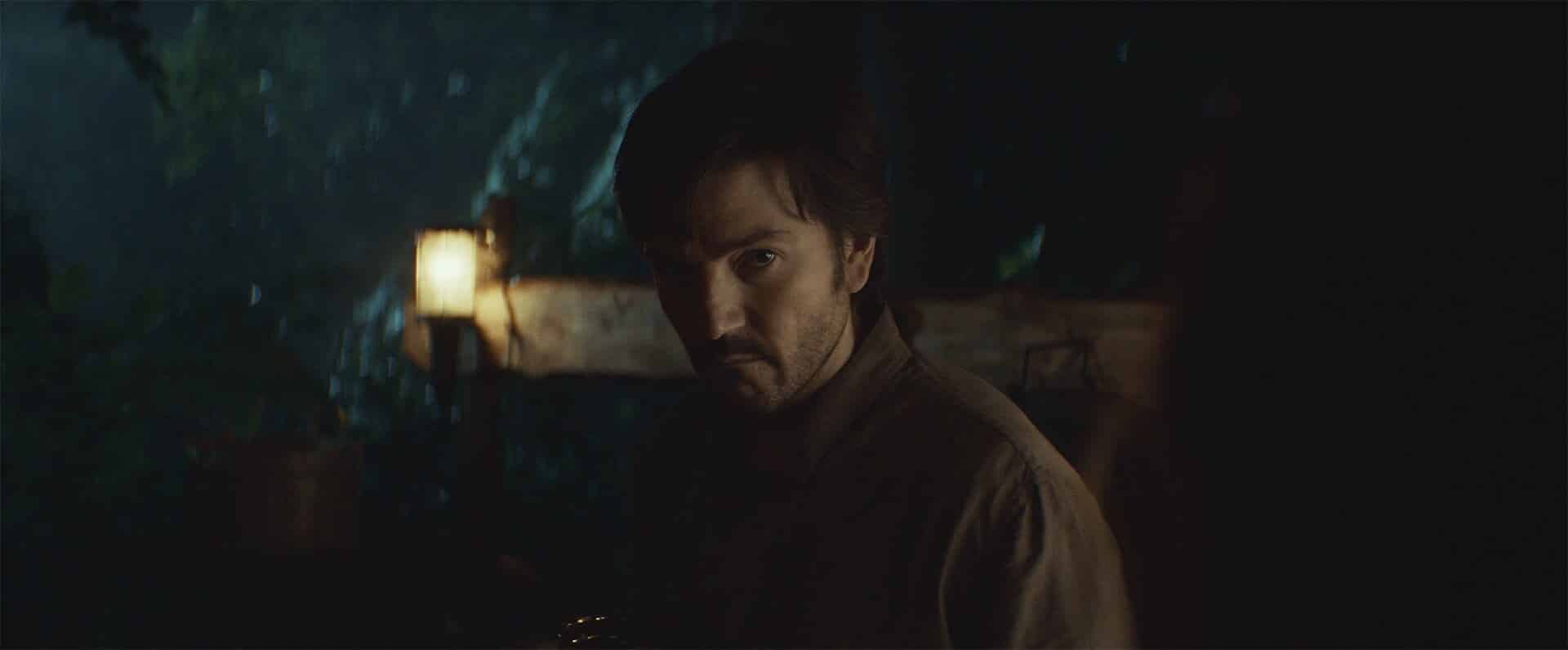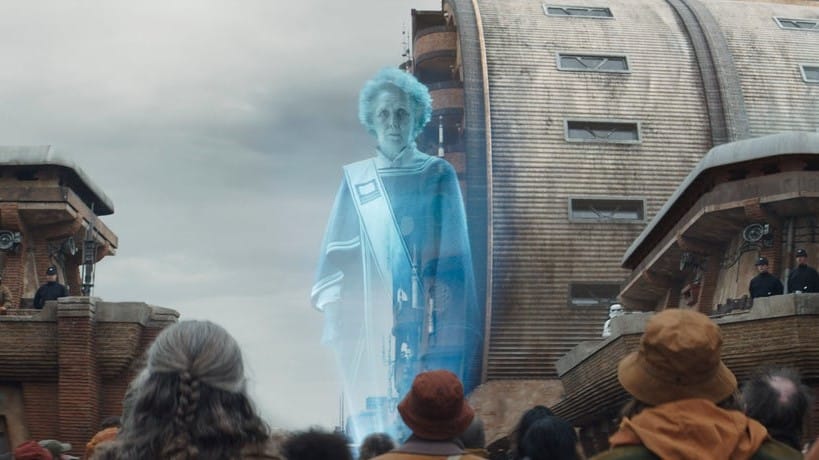The penultimate arc of Andor delivers a trio of phenomenal episodes, as the second season gets its big set piece in the course of chronicling some key Star Wars moments. Here are 10 things we loved about “Messenger,” “Who Are You?” and “Welcome to the Rebellion.”
1. The Chosen One

Andor isn’t a series (or a character) that really cries out for a Chosen One narrative, or even much to do with the Force. But the Force is there nevertheless, and its introduction to the series in this arc is about on the same level as Chirrut’s presence in Rogue One. In the end, the brief flirtations, via a Force healer on Yavin 4, with the notion that Cassian is destined for great things works not because of the impact it has on Cassian but because of how it affects Bix and pushes her to make a key decision and guide her own narrative.
— Austin Gorton
2. Outside agitators
The Imperial propaganda line on outside agitators being behind the protests on Ghorman echoes the real-world dismissal of protest movements. The term gained popularity during the Civil Rights Movement, when Southern politicians shifted the blame to “outside agitators” coming down from the North to create strife, and has been used again and again, more recently during last year’s pro-Palestinian protests on college campuses. As a concept, it’s kissing cousins with “international elites” hiring “paid protesters” to stir up trouble.
— Mark Turetsky
3. ‘Rebellions are built on hope’
Star Wars in general has a … troubled relationship with “so that’s the origin of __!” story beats (cf the origin of Han Solo’s surname in Solo). Once again, Andor leans into a sticky trope and makes it work, with the reveal that the iconic “Rebellions are built on hope” line from Rogue One was initiated by a random Ghorman hotel worker. This isn’t something that needed a backstory, but the idea that this guy who grew up in the shadow of the Tarkin Massacre before dying in the larger Ghorman massacre passed along this turn of phrase to Cassian, who then shared it with Jyn Erso, who then used it to inspire a contingent of Rebel troops to break rank and go after the Death Star plans, which in turn inspired the larger Rebel military to come and support the effort, which ultimately led to Star Wars‘ titular New Hope ultimately destroying the Death Star is a powerful statement on the way a simple idea can have a butterfly effect of consequences, both how even the most minor or unknown of people can impact the larger arc of history and how standing up against oppression in the smallest way can have a huge impact.
— Austin
4. ‘We Are the Ghor’
The protesters occupying Palmo Plaza chant “We are the Ghor! The galaxy is watching!” until Lezine begins singing the Ghor national anthem, “We Are the Ghor.” It’s a rousing and emotional tune, and the scene seemingly pulls from the Marseillaise scene from Casablanca. But whereas “La Marseillaise” is a literal rallying cry (“They’re coming right into your arms/To tear the throats of your sons, your wives!/To arms, citizens,/Form up your battalions”), “We Are the Ghor” is a song about national pride (“Call your kin to come and sing/We are the Ghor!/Voices loud and standing proud/We are the Ghor!”) and the natural beauty of their homeland (“Valley!/Highland/Let me spend my every day there!”). It’s a much more peaceful song about being secure and proud of one’s homeland. And, well, it doesn’t end as resoundingly as the scene in Rick’s Café Américain.
— Mark
5. Suspense over surprise
For the most part, the outcome of the broad strokes of these episodes is known: We know the massacre is going to happen, we know Cassian is going to survive, we know Mon Mothma is going to give her speech and escape. Yet they are still incredibly tense, suspenseful episodes, in large part because Gilroy and company lean into the “known” elements and focus on building suspense over trying to surprise the audience. A good example of this is the KX droids. They could have held them back, and not given us the image of them sitting in the Imperial waiting room before they were unleashed on the Ghor. But instead of trying to surprise the audience with their sudden appearance, they primed us to expect them, thereby ratcheting the tension up by making us know they were going to attack, but not know when.
— Austin
6. The KX droids are terrifying

When the KX droids are introduced in “Who Are You?” it’s when Syril is shuffled into a secure room. Six of them are shown sitting on long bench seats, while humans are forced to stand. They could be asked, or ordered, to stand to allow some of the humans to sit, but they radiate such silent menace that nobody there would ever be the one to make that request. Unlike some of the other combat droids in the Star Wars universe, the KX-series security droids aren’t there to be blundering cannon fodder. They don’t carry blasters, likely so that their brutality can be classed as “nonlethal.” In fact, they don’t even throw punches. They merely throw and clothesline people, killing or seriously injuring them. They don’t speak, they don’t tell people to disperse or put down their weapons. That’s not their job because the Imperial version of security is not about peacekeeping. Their form of crowd control is to escalate, to terrify people into panicking and creating more mayhem for the Imperials to feed off of. It’s a chilling introduction to Alan Tudyk’s K-2SO from Rogue One, and it will utterly upend my view of him when I watch that film when this series is finished.
— Mark
7. ‘Who Are You?’
What an utter gut-punch of an ending for Syril, his whole worldview torn down around him as he realizes he’s never been a player but a pawn, then to come face to face with his white whale, only for the white whale to have no idea who the hell he is. Andor has been Syril’s obsession. For Andor, Syril doesn’t even merit a distant memory of the CorpSec cop who chased him to Ferrix that one time years ago. It’s the perfect ending for a villain we love to hate.
— Austin
8. Dedra’s freakout
I suspect we haven’t seen the last of Dedra Meero in the series, but if we have, going out on the scene of her desperately pulling at the collar of her ISB uniform like Syril’s hands are still around her throat, then anxiously smoothing out the bottom of her tunic and generally just freaking the eff out in the wake of all the horror she unleashed would be as suitable in its way as Syril’s end. Not comeuppance, exactly, but the knowledge that, finally, something has pierced her veneer of aloof professionalism, that in some way her actions are having a negative impact on her.
— Austin
9. Melshi’s blaster
Another great example of this series’ attention to production details, the blaster Vel holds up, which Cassian’s former prisoner mate/escapee (and future “dies on Scarif, too” comrade in arms) Melshi claims, is the blaster Cassian stole in the series’ first arc, which he carried with him on Alhani, stashed on Niamos along with Nemik’s manifesto before getting arrested, then passed to Melshi after the pair escaped from the prison on Narkina 5.
— Austin
10. Sorry, she’s due to make an appearance on Rebels
The end of “Welcome to the Rebellion” synchs up beautifully with the season 3 episode of Rebels, “Secret Cargo,” in which the titular rebels help Gold Squadron safely deliver Mon Mothma to Yavin 4 following her speech decrying the Ghorman Massacre. It does so in classic Andor fashion by revealing the events in Rebels are at least partially staged, in that Rebel leadership wants Mon Mothma to arrive escorted by the visible, “official” arm of the Rebellion and not the scrappy, seedy “blow shit up” insurgency of Luthen and his agents. It’s a reminder that propaganda isn’t only for the bad guys, and fits the series’ broader presentation of Cassian as a “secret” hero.
— Austin







